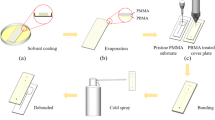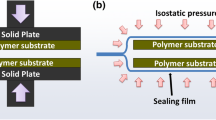Abstract
The integration of a PDMS membrane within orthogonally placed PMMA microfluidic channels enables the pneumatic actuation of valves within bonded PMMA–PDMS–PMMA multilayer devices. Here, surface functionalization of PMMA substrates via acid catalyzed hydrolysis and air plasma corona treatment were investigated as possible techniques to permanently bond PMMA microfluidic channels to PDMS surfaces. FTIR and water contact angle analysis of functionalized PMMA substrates showed that air plasma corona treatment was most effective in inducing PMMA hydrophilicity. Subsequent fluidic tests showed that air plasma modified and bonded PMMA multilayer devices could withstand fluid leakage at an operational flow rate of 9 μl/min. The pneumatic actuation of the embedded PDMS membrane was observed through optical microscopy and an electrical resistance based technique. PDMS membrane actuation occurred at pneumatic pressures of as low as 10 kPa and complete valving occurred at 14 kPa for ~100 μm by 100 μm channel cross-sections.








Similar content being viewed by others
References
Bos E-JC, Heldens RWP, Delbressine FLM, Schellekens PHJ, Dietzel A (2007) Compensation of the anisotropic behavior of single crystalline silicon in a 3D tactile sensor. Sens Actuators A Phys 134:374–381. doi:10.1016/j.sna.2006.05.043
Brown L, Koerner T, Horton JH, Oleschuk RD (2006) Fabrication and characterization of poly(methylmethacrylate) microfluidic devices bonded using surface modifications and solvents. Lab Chip 6:66–73. doi:10.1039/b512179e
Chou H-P et al (2003) Microfluidic devices and methods of use. US patent no. US 7,258,774 B2
Geschke O, Klank H, Telleman P (2003) Microsystem engineering of lab-on-chip devices. Wiley-VCH Verlag, Germany
Huang F-C, Chen Y-F, Lee G-B (2007) CE chips fabricated by injection molding and polyethylene/thermoplastic elastomer film packaging methods. Electrophoresis 28:1130–1137. doi:10.1002/elps.200600351
Lee JN, Park C, Whitesides GM (2003) Solvent compatibility of poly(dimethylsiloxane)-based microfluidic devices. Anal Chem 75:6544–6554. doi:10.1021/ac0346712
Li JM, Liu C, Dai XD, Chen HH, Liang Y, Sun HL, Tian H, Ding XP (2008) PMMA microfluidic devices with three-dimensional features for blood cell filtration. J Micromech Microeng 18:095021 (7 pp)
Nising P, Zeilmann T, Meyer T (2003) On the degradation and stabilization of poly(methylmethacrylate) in a continuous process. Chem Eng Technol 26:599–604. doi:10.1002/ceat.200390092
Risbund MV, Dabhade R, Gangal S, Bhonde RR (2002) Radio-frequency plasma treatment improves the growth and attachment of endothelial cells on poly(methyl methacrylate) substrates: implications in tissue engineering. J Biomater Sci Polym Ed 13:1067–1080. doi:10.1163/156856202320813792
Tsao CW, Hromada L, Liu J, Kumar P, Devoe DL (2007) Low temperature bonding of PMMA and COC microfluidic substrates using UV/ozone surface treatment. Lab Chip 7:499–505. doi:10.1039/b618901f
Unger MA, Chou H-P, Thorsen T, Scherer A, Quake SR (2000) Integrated elastomer fluidic lab-on-a-chip—surface patterning and DNA diagnostics. Science 288:113–116. doi:10.1126/science.288.5463.113
Xing R, Wang Z, Han Y (2003) Embossing of polymers using a thermosetting polymer mold made by soft lithography. J Vac Sci Technol B 21:1318–1322. doi:10.1116/1.1585066
Yuan D, Das S (2007) Experimental and theoretical analysis of direct-write laser micromachining of polymethyl methacrylate by CO2 laser ablation. J Appl Phys 101:024901 (6 pp)
Acknowledgment
This research is funded by the Agency for Science, Technology and Research (A*STAR), Singapore.
Author information
Authors and Affiliations
Corresponding author
Rights and permissions
About this article
Cite this article
Toh, A.G.G., Ng, S.H. & Wang, Z. Fabrication and testing of embedded microvalves within PMMA microfluidic devices. Microsyst Technol 15, 1335–1342 (2009). https://doi.org/10.1007/s00542-009-0821-6
Received:
Accepted:
Published:
Issue Date:
DOI: https://doi.org/10.1007/s00542-009-0821-6




